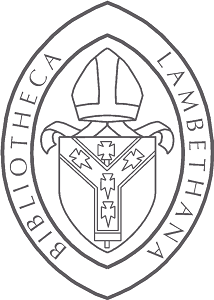Lambeth Palace Library recently hosted a visit from a group of students from Emanuel School in south-west London. These ten students are all in their sixth year and studying Greek or Latin. They and their teachers came to test their translating skills with some of the books in the Sion Collection. The Sion Collection is currently being cataloged and conserved to make it available to the public.
The first stop on the tour was the recently refurbished Great Hall. They were told about the Great Hall’s previous use as the library reading room, the effects of the bomb that fell during the Second World War and the recent work that has been carried out to improve conditions for the books. We were lucky that the cases had displays of Sion books from the recent Friends Meeting. These items prompted many excited questions about conservation and binding styles. Many of the books on display in the cases were written in Latin or Greek and they started to work out the translations through the glass!

After a few other stops, we assembled in the Audience Chamber. Copies of several texts previously selected by the teachers were available and the students broke into groups, took out their dictionaries and set to work translating Homer, Cicero and Aesop.

The students were a really great bunch and continually interested and engaged throughout the afternoon. The teachers were very pleased about the amount of confidence that the students gained from translating a text with which they had not previously worked. One of the students, Thais Warren, shares her expereince of the day below:
On the 4th of December our AS Latin class of 10 was given the privilege of visiting Lambeth palace and its library. Initially we entered the palace and into the great hall, where the library was originally housed. Under the gothic hammer beam roof of the hall we were shown numerous books and explained different forms of conservation used on them, as well as the history of the hall and palace itself. On display in the great hall were numerous beautiful manuscripts from the Sion collection. Most memorable was the 1534 edition of the works of Plato of Sir Thomas Smith, with quaint marginalia such as that of a beautiful ship, an interesting mnemonic technique.
We then headed for the prison, passing by the ancient fig trees of the palace courtyard. We ascended the Lollard’s tower, up the dizzying spiral staircase until we reached the already quite dark room used for the prison. With torches on our phones we found 17th century graffiti on the walls of the prison room, which are much more elegant than present day graffiti. Shortly after, we passed into the chapel to briefly admire the intricate stained glass windows and the more modern vivid ceiling artwork.
After our tour of parts of the palace we most excitingly were split into pairs and given photocopies of historic printing in either Greek or Latin to work with and (attempt to) translate! There were copies of Cicero’s speeches from the 1700s and excerpts of Aesop’s fables from 1582, for example. I was personally working with the beginning of book 12 of Homer’s Odyssey in Greek. The book was from a printing workshop in Amsterdam and included both Greek and Latin (most helpfully) on the side, and footnotes in ancient Greek itself. Translating the Greek was hard work, and the use of a dictionary and my teacher was mandatory. The Latin on the right of the Greek text did really help too as quite interestingly some of the Greek letters were printed in ways I had never before seen, so helped to piece together the Greek as well as test my Latin. In the end it was the most exciting thing to realise that I had just translated (with a little help from my teacher!), 10 lines of original Homer in ancient Greek printed in 1655. It was an amazing feeling to be able to piece such an iconic work of literature together in my own translation from the original, and to encounter famous Homeric epithetical phrases in the original Greek. This was an incredible experience and extremely different to translation we may do in the classroom, and is great preparation for university and the future. Thank you on behalf of the Emanuel School Latinists.
Thais Warren
A selection of texts used by the students:



The Library is open to the public Tuesday, Wednesday and Friday from 10:00-17:00 and open late on Thursdays from 10:00-19:30. Although free to use, a Readers Ticket is required. Please see this for more information.

